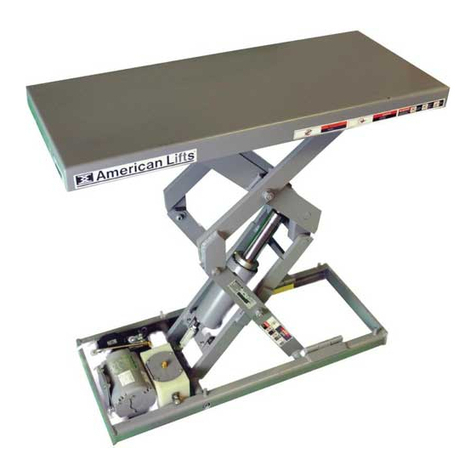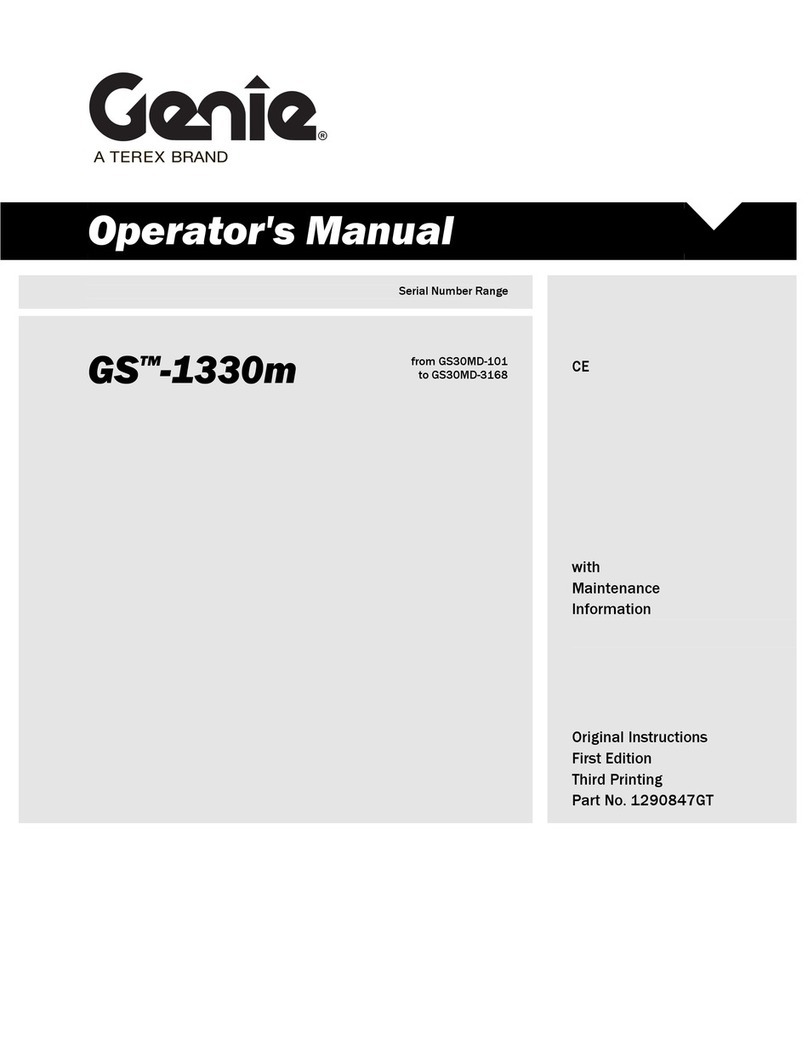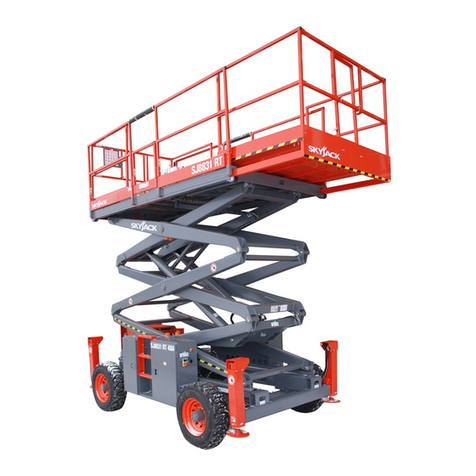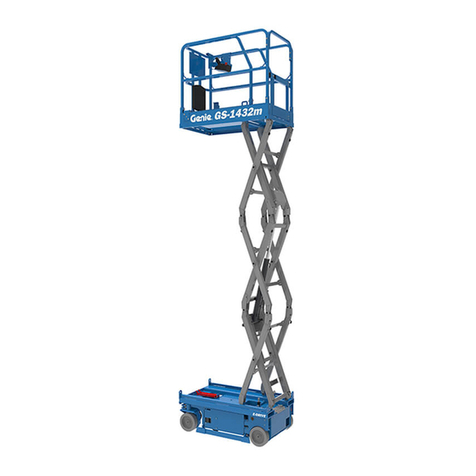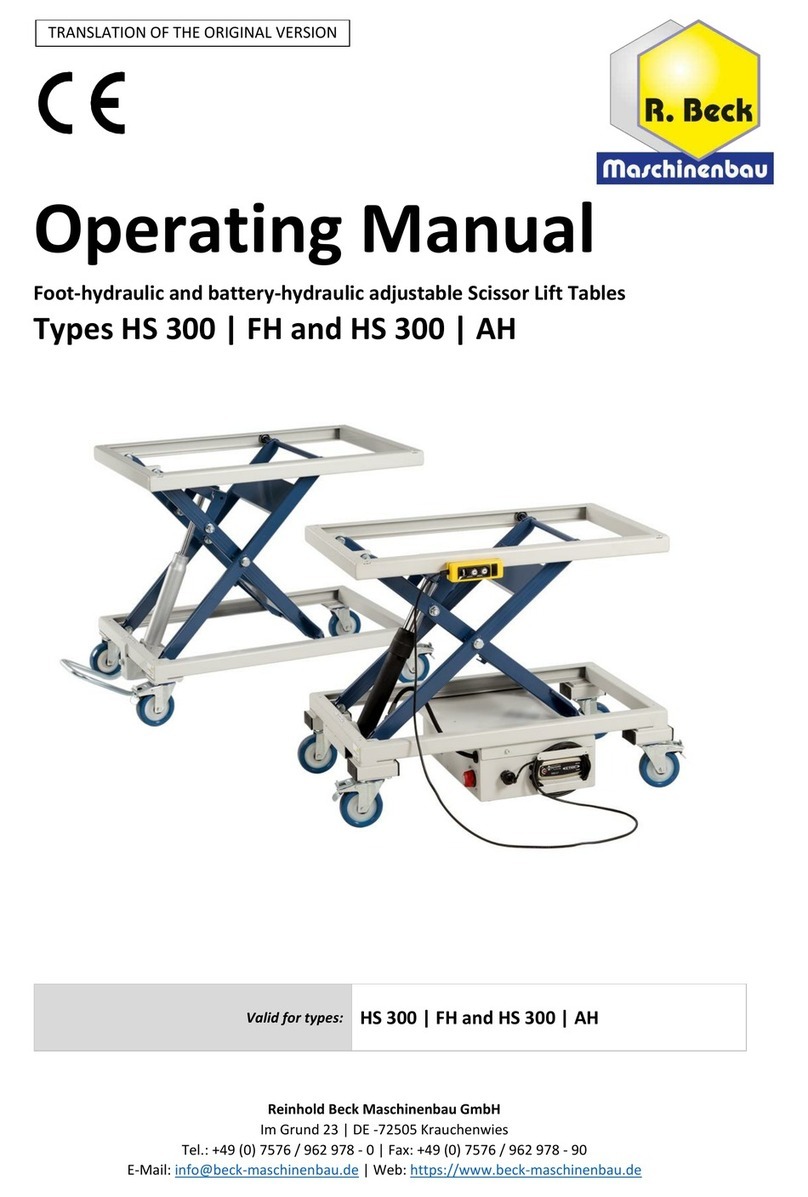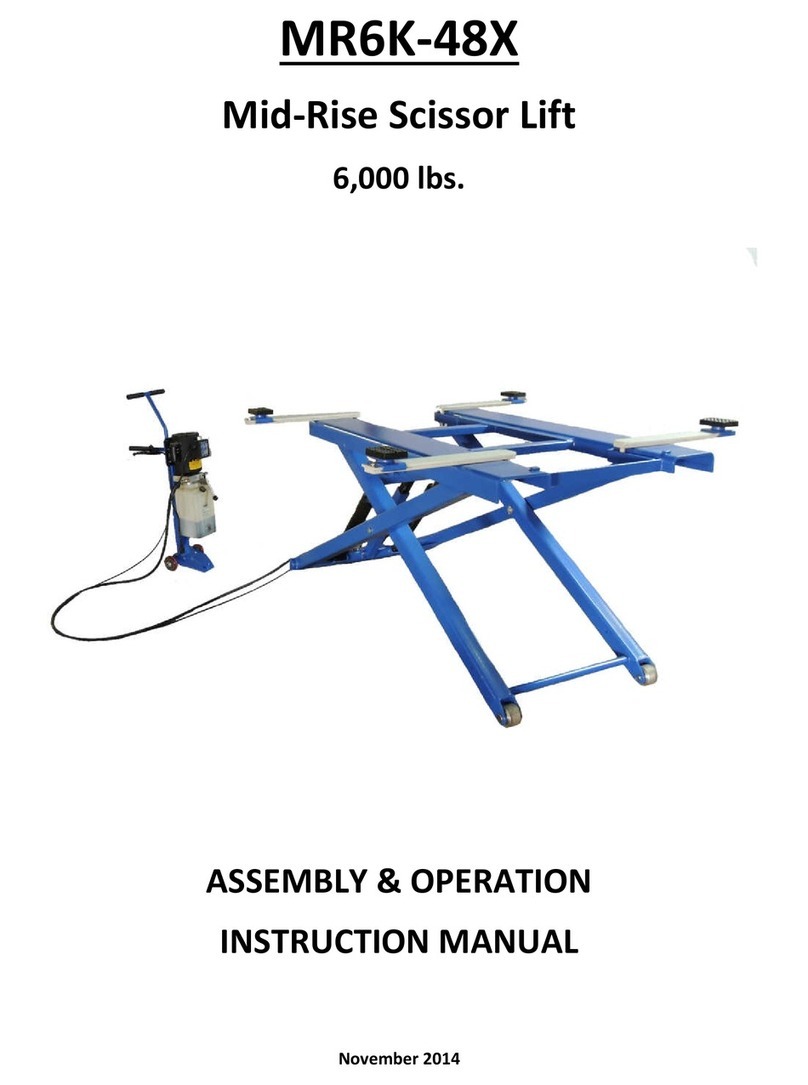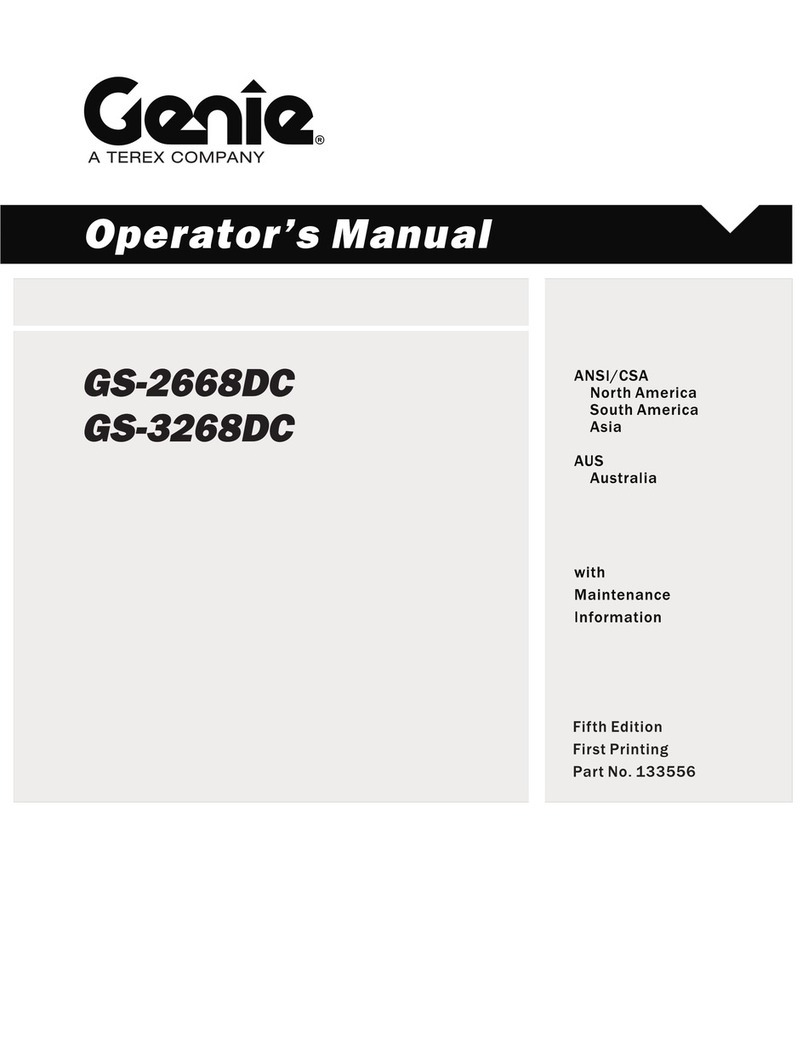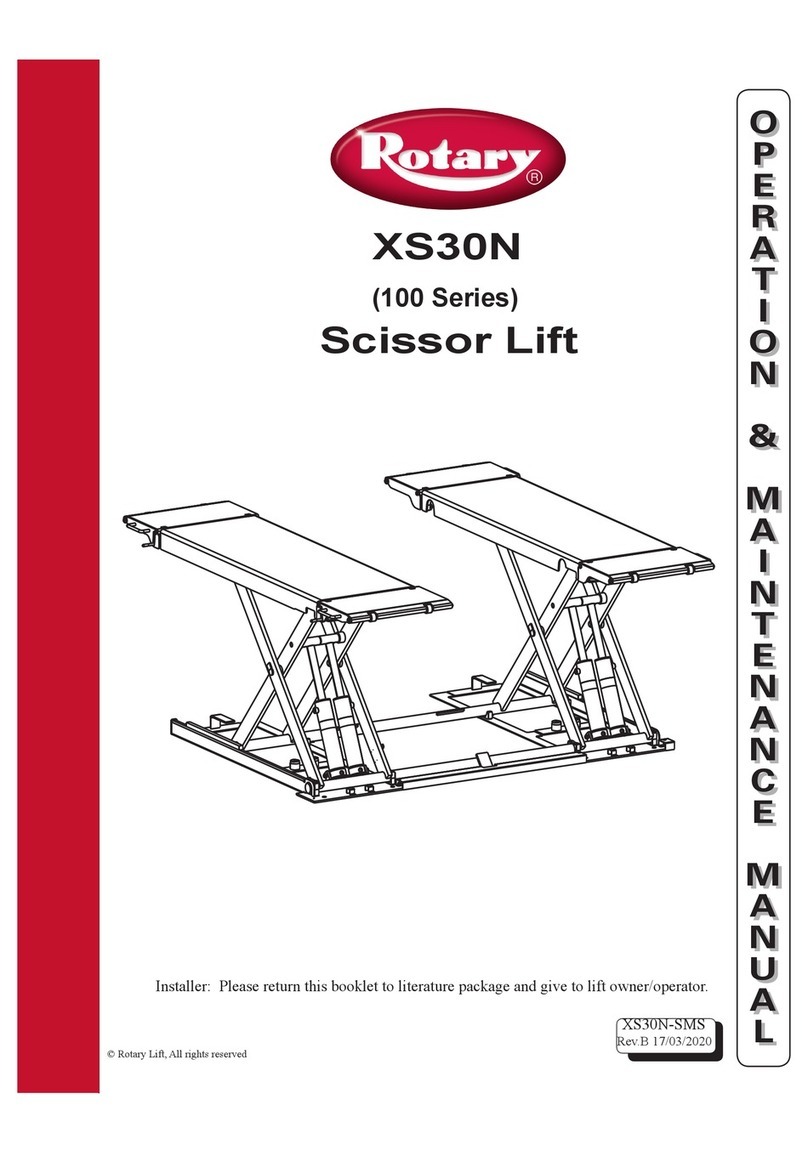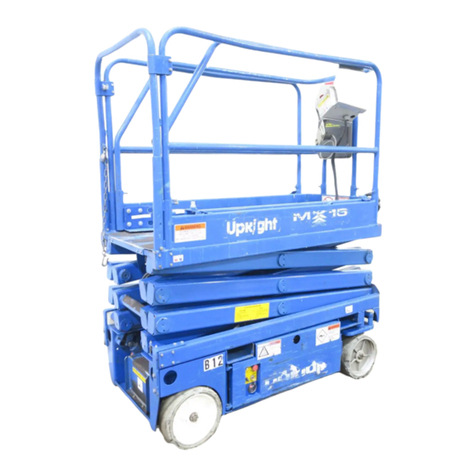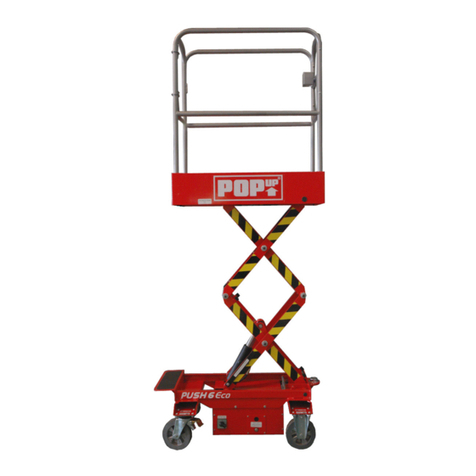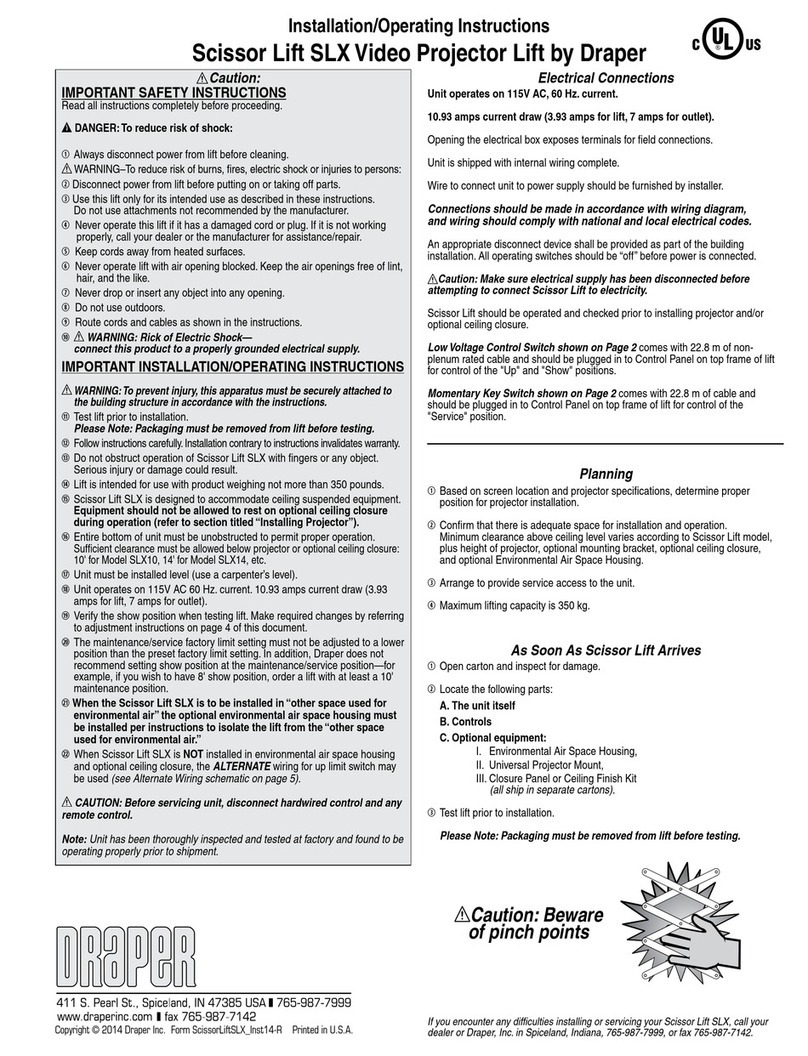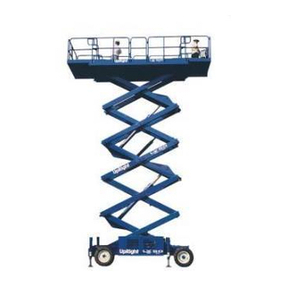Autoquip PLTC-6050 Setup guide

1
INSTALLATION, OPERATION
AND SERVICE MANUAL
PLTC SCISSORS DOCK LIFT
1058 West Industrial Avenue Guthrie, OK 73044-1058 888-811-9876
405-282-5200 FAX: 405-282-3302 www.autoquip.com
Item # 830PLT Version 6.0
10/2017

2
1. Introduction And Warranty............................................................................................................4
1.1 Introduction.................................................................................................................................4
1.1.1 Identification..........................................................................................................................4
1.1.2 Inspection..............................................................................................................................4
1.1.3 Planned Maintenance Program.............................................................................................4
1.2 Responsibility Of Owners/Users..................................................................................................4
1.2.1 Deflection..............................................................................................................................4
1.2.2 Inspection & Maintenance.....................................................................................................5
1.2.3 Removal From Service..........................................................................................................5
1.2.4 Repairs .................................................................................................................................5
1.2.5 Operators..............................................................................................................................5
1.2.6 Before Operation...................................................................................................................5
1.2.7 During Operation...................................................................................................................5
1.2.8 Modifications Or Alterations...................................................................................................5
1.3 Warranty.....................................................................................................................................6
2. Specifications.................................................................................................................................7
2.1 Model Specifications...................................................................................................................7
2.2 Lift Specifications........................................................................................................................8
2.3 Load Capacity.............................................................................................................................8
2.4 Unbalanced Loading...................................................................................................................8
2.5 Pump Pressure...........................................................................................................................8
2.6 Lift Duty ......................................................................................................................................8
3. Safety..............................................................................................................................................9
3.1 Safety Signal Words ...................................................................................................................9
3.2 Installation...................................................................................................................................9
3.3 Operation....................................................................................................................................9
3.4 Hydraulics.................................................................................................................................10
3.5 Maintenance.............................................................................................................................11
3.6 Modifications.............................................................................................................................11
3.7 Labels.......................................................................................................................................12
4. Installation....................................................................................................................................15
4.1 Remote Power Unit Installation.................................................................................................15
4.2 Power Unit Wiring.....................................................................................................................15
4.2.1 Contractor Remote Power Unit............................................................................................15
4.2.2 Heavy Duty Remote Power Unit..........................................................................................15
4.3 Pit Installation ...........................................................................................................................16
4.4 Surface Installation ...................................................................................................................21
4.5 Shimming And Anchoring Lift To Concrete................................................................................21
4.6 Bridge Lifting Chain Installation –Steel Bridge..........................................................................22
4.7 Bridge Lifting Chain Installation –Aluminum Bridge..................................................................23
4.8 Bridge Winch Installation –Steel Bridge ...................................................................................24
4.9 Bridge Winch Installation –Aluminum Bridge............................................................................25
4.10 Pit Modification & Installation for Mechanical Wheel Chock ......................................................26
4.11 Accordion Skirt Installation........................................................................................................27
5. Operation......................................................................................................................................28
5.1 Raise And Lower Lift.................................................................................................................28
5.2 Raise And Lower Bridge (hydraulic)..........................................................................................28
6. Maintenance .................................................................................................................................29
6.1 Maintenance Device .................................................................................................................29
6.2 Routine Maintenance................................................................................................................31
6.2.1 Every Day Or 10 Hours Of Operation..................................................................................32
6.2.2 Every Month Or 100 Hours Of Operation.............................................................................32
6.2.3 Every Year Or 1000 Hours Of Operation.............................................................................32
6.2.4 Oil Requirements ................................................................................................................33
6.2.5 Oil Capacity.........................................................................................................................33

3
6.3 General Maintenance ...............................................................................................................33
6.3.1 Hydraulic Cylinder Repair ...................................................................................................33
6.3.2 Bleeding Air From System ..................................................................................................36
6.3.3 Hydraulic Velocity Fuse and Flow Control (VF/FC) Replacement........................................36
6.3.4 Hose Orientation.................................................................................................................37
6.3.5 Schematics and Field Wiring Details...................................................................................38
6.3.6 Troubleshooting..................................................................................................................50
7. Parts Lists .................................................................................................................................... 54

4
1. INTRODUCTION AND WARRANTY
1.1 Introduction
Please read and understand this manual prior to installation or operation of this lift. Failure to do so could
lead to property damage and/or serious personal injury. If you have any questions, call a local dealer or
Autoquip Corporation at 1-888-811-9876 or 405-282-5200.
Please record the following information and refer to it when calling your dealer or Autoquip.
Model Number:________________Serial Number: ___________________
Installation Date _____/_____/_____
1.1.1 Identification
When ordering parts or requesting information or service on this lift, PLEASE REFER TO THE MODEL
AND SERIAL NUMBER. This information is on a nameplate attached to the leg assembly. Replacement
parts are available from a local Autoquip distributor.
1.1.2 Inspection
Upon receipt of lift, perform a visual inspection to determine whether the lift has been damaged in transit.
Any damage found must be noted on delivery receipt. In addition to this preliminary inspection, carefully
inspect lift for concealed damage. Any concealed damage found that was not noted on delivery receipt
must be reported in writing to the delivering carrier within 48 hours.
Use the following checklist for inspection of lift:
1. Examine entire unit for any signs of mishandling. Carefully check power unit and controls.
2. Thoroughly examine all connections, making sure they have not vibrated loose during transit, and
inspect wiring for any signs of damage.
3. After installation, raise lift and inspect base frame, platform, scissors assembly, and cylinder plumbing
connections.
1.1.3 Planned Maintenance Program
A local Autoquip representative provides a Planned Maintenance Program (PMP) for this equipment using
factory-trained personnel. Call a local representative or Autoquip Corporation at 1-888-811-9876 or 405-
282-5200 for more information.
1.2 Responsibility Of Owners/Users
1.2.1 Deflection
It is the responsibility of user/purchaser to advise manufacturer where deflection may be critical to the
application.

5
1.2.2 Inspection & Maintenance
Lift must be inspected and maintained in accordance with Autoquip’s operating/maintenance (O&M)
manual and with other applicable safe operating practices.
1.2.3 Removal From Service
Any lift not in safe operating condition such as, but not limited to, excessive leakage, missing parts or
fasteners, any bent or cracked structural members, cut or frayed electric, hydraulic, or pneumatic lines,
damaged or malfunctioning controls or safety devices, etc. shall be removed from service until it is
repaired to the original manufacturer’s standards.
1.2.4 Repairs
All repairs must be made by a qualified technician in conformance with Autoquip’s instructions.
1.2.5 Operators
Only trained personnel and authorized personnel shall be permitted to operate lift.
1.2.6 Before Operation
Before using lift, operator must:
Read and/or had explained, and understood, manufacturer’s operating instructions and safety
rules.
Inspect lift for proper operation and condition. Any suspect item must be carefully examined and a
determination made by a qualified person as to whether it constitutes a hazard. All items not in
conformance with Autoquip’s specification must be corrected before operating lift.
1.2.7 During Operation
Use lift in accordance with Autoquip’s O&M manual.
Do not overload lift.
Verify all safety devices are operational and in place.
Autoquip warrants this lift for 60,000 cycles each warranty year. This number of cycles represents
normal, single shift duty. Exceeding this number of cycles shortens life of lift and length of your
warranty.
1.2.8 Modifications Or Alterations
Modifications or alterations to this equipment may be made only with written permission of Autoquip.
Unauthorized modification or alteration will void warranty.

6
1.3 Warranty
The user is solely responsible for using this equipment in a safe manner and observing all of the safety
guidelines provided in the Owner’s Manual and on the warning labels provided with the lift. If you are
unable to locate either the manual or the warning labels, please contact Autoquip or access
www.autoquip.com for replacement downloads or information.
Autoquip Corporation expressly warrants that this product will be free from defects in material and
workmanship under normal, intended use for a period of Two (2) Years for Labor and all electrical,
mechanical, and hydraulic components, parts or devices, and warrants the structure of the lift against
breakage or failure for a period of Five (5) years. The warranty period begins from the date of shipment.
When making a claim, immediately send your dealer or Autoquip notice of your claim. All claims must be
received by Autoquip within the warranty time period. The maximum liability of Autoquip, under this
Limited Warranty, is limited to the replacement of the equipment.
This warranty shall not apply to any Autoquip lift or parts of Autoquip lift that have been damaged or
broken in transit/shipping, or due directly or indirectly to misuse, abuse, vehicle impact, negligence, faulty
installation, fire, floods, acts of God, accidents, or that have been used in a manner contrary to the
manufacturer’s limitations or recommendations as stated in the manual, or that have been repaired,
altered or modified in any manner outside of Autoquip Corp’s manufacturing facility or which have not
been expressly authorized by Autoquip.
Autoquip Corporation makes no warranty or representation with respect to the compliance of any
equipment with state or local safety or product standard codes, and any failure to comply with such codes
shall not be considered a defect of material or workmanship under this warranty. Autoquip Corporation
shall not be liable for any direct or consequential damages resulting from such noncompliance.
Autoquip Corporation’s obligation under this warranty is limited to the replacement or repair of defective
components at its factory or another location at Autoquip Corp’s discretion at no cost to the owner. This is
owner’s sole remedy. Replacement parts (with exception of electrical components) will be warranted for a
period of ninety (90) days. Except as stated herein, Autoquip Corporation will not be liable for any loss,
injury, or damage to persons or property, nor for direct, indirect, or consequential damage of any kind,
resulting from failure or defective operation of said equipment. All parts used to replace defective material
must be genuine Autoquip parts in order to be covered by this Limited Warranty.
AUTOQUIP CORP
P.O. Box 1058, Guthrie, OK 73044-1058
Telephone: (888) 811-9876 ∙ (405) 282-5200
Fax: (405) 282-3302
www.autoquip.com

7
2. SPECIFICATIONS
2.1 Model Specifications
Model
Travel
(inches)
Capacity
(lbs)
Platform
Width
(inches)
Platform
Length
(inches)
Lowered
Height
(inches)
Shipping
Weight
Approx.
(lbs)
Axle Load Capacity
Clevis End
(Bridge)
(lbs)
Roller End
(lbs)
Sides
(lbs)
PLTC-6050
60
5000
72
100
8
2800
3000
3000
2500
6050A
60
5000
96
100
8
3300
3000
3000
2000
6050S
60
5000
72
120
8
3400
2000
2000
2500
6050B
60
5000
84
120
8
3400
2000
2000
2250
6050K
60
5000
96
120
8
3600
2000
2000
2000
PLTC-6060
60
6000
72
100
8
3000
3000
3000
2500
6060A
60
6000
96
100
8
3400
3000
3000
2000
6060S
60
6000
72
120
8
3400
2000
2000
2500
6060B
60
6000
84
120
8
3500
2000
2000
2250
6060K
60
6000
96
120
8
3600
2000
2000
2000
PLTC-6070
60
7000
72
96
12
4600
6400
6400
6400
6070A
60
7000
96
96
12
4780
6400
6400
5400
6070S
60
7000
72
120
12
4800
6400
6400
6400
6070B
60
7000
84
120
12
4900
6400
6400
6000
6070K
60
7000
96
120
12
5100
6400
6400
5400
PLTC-6080
60
8000
72
96
12
4700
6400
6400
6400
6080A
60
8000
96
96
12
4890
6400
6400
5400
6080S
60
8000
72
120
12
4800
6400
6400
6400
6080B
60
8000
84
120
12
5100
6400
6400
6000
6080K
60
8000
96
120
12
5300
6400
6400
5400
PLTC-60100
60
10000
72
100
12
4800
8000
8000
6400
60100A
60
10000
96
100
12
4990
8000
8000
5400
60100S
60
10000
72
120
12
4900
6400
6400
6400
60100B
60
10000
84
120
12
5200
6400
6400
6000
60100K
60
10000
96
120
12
5400
6400
6400
5400
PLTC-58120
58
12000
72
100
12.5
4900
10000
10000
8000
58120A
58
12000
96
100
12.5
5100
10000
10000
6400
58120S
58
12000
72
120
12.5
5300
8000
8000
8000
58120B
58
12000
84
120
12.5
4950
8000
8000
7200
58120K
58
12000
96
120
12.5
5500
8000
8000
6400
PLTC-58150
58
15000
72
100
12.5
4900
10000
10000
8000
58150A
58
15000
96
100
12.5
5100
10000
10000
6400
58150S
58
15000
72
120
12.5
5300
8000
8000
7200
58150B
58
15000
84
120
12.5
4950
8000
8000
8000
58150K
58
15000
96
120
12.5
5500
8000
8000
6400
NOTES:
All PLTC Models have a rollover capacity equal to twice the lifting capacity when in the fully lowered
position.
All PLTC Models have (2) lifting cylinders.

8
2.2 Lift Specifications
There are many custom designs whose specifications may vary from those published for standard models.
Please consult the specific General Arrangement (GA) Drawing to obtain the specifications for application-
specific designs.
2.3 Load Capacity
Load capacity rating is stamped on a metal nameplate attached to lift. This figure is a net capacity rating
for a lift furnished with a standard platform. If optional items are installed on lift after leaving manufacturer,
deduct weight of these from load rating to obtain net capacity.
Do not exceed rated capacity of lift. Loading lift beyond its rated capacity is unsafe, will shorten
operational life of lift, and will void warranty.
2.4 Unbalanced Loading
The stabilization provided is basically for balanced loads. If special attachments extend beyond the length
and/or width dimensions of platform, end and/or side load capacity is reduced 2% for each one-inch
extension from edge of platform. If load is rolling onto platform (in any but fully-lowered position) end
and/or side load capacity is reduced by dividing the rated end/side load by 1.50 to establish an available
“axle” load.
2.5 Pump Pressure
This lift incorporates a unique, positive displacement pump. Therefore, standard factory models of same
manufacture cannot replace it.
Pump can operate efficiently at intermittent pressures up to 3200 PSI and continuous duty to 2500 PSI.
The factory installed safety relief valve is factory-set to stay within parameters of pump and lift
requirements.
2.6 Lift Duty
Autoquip warrants this lift for 60,000 cycles each warranty year. This number of cycles represents normal,
single shift duty. Exceeding this number of cycles shortens life of lift and length of your warranty
It is the responsibility of the user to notify Autoquip whenever a specific application is likely to demand
“above normal” duty from lift. Above normal duty typically requires supplemental design features to
enhance serviceable life of lift and to avoid loss of warranty.

9
3. SAFETY
3.1 Safety Signal Words
This Owner’s Manual covers PLTC lift models produced by Autoquip. Before installing, operating or
servicing lift, you must read, understand and follow the instructions and safety warnings in this manual.
Your lift may not be equipped with some optional equipment shown in this manual.
The safety information in this manual is denoted by the safety alert symbol: i
The level of risk is indicated by the following signal words.
DANGER –Indicates a hazardous situation, which, if not avoided, will
result in death or serious injury.
WARNING –Indicates a hazardous situation, which, if not avoided, could
result in death or serious injury.
CAUTION –Indicates a hazardous situation, which, if not avoided, could
result in minor or moderate injury.
NOTICE –Indicates a situation that could result in damage to
the lift or other property.
3.2 Installation
Do not install lift in a pit unless lift has a bevel toe guard or other
approved toe protection. A shear point can exist which can cause
severe foot injury.
Lift platforms traveling below floor levels may create a toe hazard
as load passes top edge of pit. This may require guarding in
accordance with Federal Regulations. Guarding must be installed prior to
operating lift.
Prevent serious injury or death.
Depending on model, standard weight of lift ranges from 2800 –5500 lbs.
Use a properly rated lifting device to move and install lift.
3.3 Operation
iDANGER
iWARNING
iCAUTION
NOTICE
iWARNING
iWARNING

10
Prevent serious injury or death.
Scissor lifts are designed for a specific load and application. Do not
change load or application from original design.
Overloading, or uneven loading, could result in load instability and cause
serious personal injury.
Stay clear of lift while lift is in motion.
Never stand, sit or ride on lift unless equipped with OSHA-compliant
personnel guarding on the platform.
Prevent serious injury or death.
Lifts which travel to an elevation above floor level where distance between
floor and the underside of lift platform exceeds 66" must have the
scissors mechanism guarded per ANSI MH29.1.
3.4 Hydraulics
Fluids can be hazardous. Before servicing lift, check Material Safety Data Sheet (MSDS) to understand
the product, safe handling procedures, and first aid measures relating to product. Follow this information
when servicing or repairing lift.
Do not drain or pour any fluids or lubricants into ground. Check with local environmental agencies,
recycling centers, or your Autoquip dealer for correct disposal information.
Any time velocity fuses have been tripped, investigate cause of trip and
verify necessary corrective actions have been taken prior to operation of
lift.
Prevent serious injury or death.
Do not attempt to remove Hydraulic Velocity Fuse (HVF) until maintenance
device securely supports lift and all hydraulic pressure has been relieved.
HVF is attached to elbow fitting in pressure port of cylinder. Do not use a
swivel fitting between HVF and cylinder. If HVF is installed improperly, it
will not lock up in event of a hydraulic line failure.
iWARNING
iWARNING
iCAUTION
iWARNING
iWARNING

11
Pressurized fluids can penetrate the skin.
Hydraulic hoses can fail from age, damage and exposure.
Do not search for hydraulic leaks without body and face protection. A tiny,
almost invisible leak can penetrate the skin, thereby requiring immediate
medical attention.
Use wood or cardboard to detect hydraulic leaks, never your hands.
Spilled fluids and lubricants may be slippery and may also present
a fire hazard.
Clean up spilled fluids and lubricants.
3.5 Maintenance
Prevent serious injury or death.
Disconnect and/or lock out electrical supply to power unit prior to any
maintenance being performed.
Prevent serious injury or death.
Never go under lift platform until load is removed and scissors
mechanism is securely blocked in raised position with
maintenance devices.
3.6 Modifications
Prevent serious injury or death.
Do not modify lift. Autoquip cannot foresee and is not responsible for
injury or damage which results from unauthorized modifications or
misuse of lift.
iWARNING
iWARNING
iWARNING
iWARNING

12
3.7 Labels
To protect against death or serious injury, all labels must be on lift and
must be legible.
If any of these labels are missing or cannot be read, call Autoquip for
replacement labels.
iWARNING

13
1 –DECAL_CAPACITY
2 –36430050
3 –36401487
4 –36401560
5 –06100010

14
6 –36403225
7 –36400265
8 –36400257
9 –36403720
10 –36433670

15
4. INSTALLATION
4.1 Remote Power Unit Installation
1. The remote power unit is to be located in an area protected from the elements and should be installed
prior to the lift to facilitate lift operation during installation into the pit.
2. The remote contractor power unit is equipped with power unit mounting brackets and can be wall or
floor mounted using these brackets. If equipped with a vertical power unit, optional power unit
mounting brackets must be used for wall mounting.
3. The electrical work is to be done in accordance with local codes by a qualified electrician. See the
“Maintenance” section for the standard wiring diagram.
4. If permanent electrical work is not complete, some means of temporary power with an on/off device for
the motor will be required.
5. Fill the reservoir with oil per instructions in the "Maintenance” section.
4.2 Power Unit Wiring
4.2.1 Contractor Remote Power Unit
1. The Contractor Power Unit utilizes a 5 HP / 208-230-460 Volt / 60 hertz / 3 phase “Super-Torque”
intermittent duty motor with (one full lift cycle per 2 minute period) driving a high pressure positive
displacement pump assembly with an internal relief valve, check valve and down solenoid valve.
2. Because an Autoquip "Super-Torque" motor actually delivers substantially more horsepower than the
nameplate rating, it must always be wired for heavier current-draw than standard motors of the same
nameplate rating. However, because of the "Super-Torque" motor’s starting efficiency and superior
running characteristics, circuit components do not have to be as large as for standard motors of equal
delivered horsepower.
3.
4.2.2 Heavy Duty Remote Power Unit
1. The Vertical 'HD' Power unit utilizes a 5 HP/ 208-230-460 Volt / 60 hertz / 3 phase Heavy Duty motor,
(with a 30 minute continuous duty rating). The power unit is coupled with a high-pressure positive
displacement gear pump, and Autoquip Corporation’s patented Deltatrol valve assembly.
2. The motor connection diagram should be referenced in connecting the motors to a power source.
Remember that heavy wire must be used all the way to the power source.
3.
NOTE: For larger horsepower motors, consult factory.
Motor Details
Full Load Amps
HP
HZ
PH
RPM
Time Rating
115V
208V
230V
460V
3
60
1
1725
2 Min.
33.6
16.8
16.8
-
5
60
1
1800
2 Min.
-
25.2
23.0
-
5 (Contractor )
60
3
3450
2 Min.
-
15.8
14.8
7.4
5 (Vertical HD)
60
3
3475
2 Min.
-
16.0
15.2
7.6
5 (Continuous)
60
3
1760
Continuous
-
13.6
12.6
6.6

16
Prevent serious injury or death.
Electrical service installation must be performed by a licensed
electrician and conform to all local and national electrical codes.
4.3 Pit Installation
Do not install lift in a pit unless lift has a bevel toe guard or other
approved toe protection. A shear point may exist which can cause
severe foot injury.
Lift platforms traveling below floor levels may create a toe hazard as load
passes top edge of pit. This may require guarding in accordance with
ANSI MH29.1. Guarding must be installed prior to operating lift.
1. Check pit dimensions (Reference drawing 82600431 below). Pit should be 2" longer and 2” wider than
lift platform to allow a 1” gap between platform and pit. Pit depth should allow ½” for shims or grout.
2. Conduit diameter must be a minimum of 3" with long radius sweeps for necessary hydraulic hosing
and field wiring.
3. Verify installation area is clean before starting. Check mounting surface of pit floor with a level or
straight edge. If floor is not level, add shims or grout under entire perimeter of base to achieve a level
and flat base installation. A level base is essential for proper wheel tracking and smooth lift operation.
Prevent serious injury or death.
Depending on model, standard weight of lift ranges from 500 –4700 lbs.
Use a properly rated lifting device to move and install lift.
iWARNING
iWARNING
iWARNING

17
PLT Pit Detail
See Pit Installation Notes

18
4. Make temporary hose connections with high-pressure hose (see chart below) to allow the lift to be
operated when it is set in the pit.
5. Temporarily connect electrical service and hydraulic hoses. The hose connection on the end of the
base frame is 1/2" female NPT.
Hydraulic Piping/Hose Size
Up to 25 feet
½” ID
26 feet to 50 feet
¾” ID
Over 50 feet
1” ID
6. Fittings have been provided to extend the hose connection outside the bevel toe guard. Point the
elbow toward the pipe chase in the pit.
7. Check the routing of the temporary hydraulic lines to assure that the hose is clear of legs, base frame,
and platform when lift is in the lowered position.
8. Using 3/4-10 UNC eyebolts and a chain spreader, place the lift into the pit as illustrated below.

19
Lifting and Installation

20
9. Check for proper height. Lift must be solid and flush with pit curb angle framing (D). If needed, shim to
desired height. DO NOT “spot” shim. Shim along full length of frame. This will prevent frame from
sagging under load.
10. Remove the shipping bolt and eye bolts from the lift and hydraulically raise the platform.
Failing to remove the shipping bolts before operation will cause
permanent damage to the lift.
11. Fill hydraulic reservoir with proper type and volume of fluid.
12. Press “UP button and raise lift one foot.
13. Press “DOWN” button to fully lower lift. Continue to hold down button for
60 seconds. Repeat procedure five to seven times to bleed air out of
hydraulic system.
14. Raise and lower lift as needed to make positioning adjustments.
15. Adjust platform to a clearance of 1” minimum around perimeter between
platform and pit angle.
NEVER go under a raised lift platform until load is removed and
lift is securely blocked in raised position with maintenance
devices.
See "Maintenance Device" section of this manual.
Lock-out/tag-out power source.
16. Base frame of lift has pre-drilled holes for anchoring to the floor. Anchor lift to floor. Lifts with oversize
platforms have minimum pull out requirements of 2,000 lbs. for each anchor. See “Shimming And
Anchoring Lift To Concrete”.
17.
18. Make permanent electrical and hydraulic connections and operate lift through a few cycles.
19. Clean up debris and spilled oil from area. Dispose of oil in an environmentally safe manner.
20. Touch-up paint is available from Autoquip for repair of damaged paint surfaces.
21. Train personnel on lift operation, all safety features and procedures.
iCAUTION
iWARNING
This manual suits for next models
33
Table of contents
Other Autoquip Scissor Lift manuals
